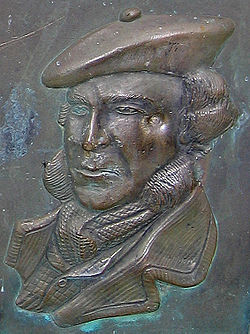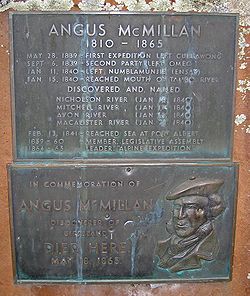
Angus McMillan
Encyclopedia

Gippsland
Gippsland is a large rural region in Victoria, Australia. It begins immediately east of the suburbs of Melbourne and stretches to the New South Wales border, lying between the Great Dividing Range to the north and Bass Strait to the south...
, Victoria, Australia
Australia
Australia , officially the Commonwealth of Australia, is a country in the Southern Hemisphere comprising the mainland of the Australian continent, the island of Tasmania, and numerous smaller islands in the Indian and Pacific Oceans. It is the world's sixth-largest country by total area...
. He is also known for being an instigator of many of the massacres against the Aboriginal peoples in the Gippsland region.
Early life
Angus McMillan was born in Glenbrittle, Isle of Skye, ScotlandScotland
Scotland is a country that is part of the United Kingdom. Occupying the northern third of the island of Great Britain, it shares a border with England to the south and is bounded by the North Sea to the east, the Atlantic Ocean to the north and west, and the North Channel and Irish Sea to the...
, the fourth son of Ewan McMillan. After an early life of hardship and deprivation he migrated to Australia in 1838. Under the initial employ of Captain Lachlan Macalister he gained experience of Australian pastoral
Pastoral
The adjective pastoral refers to the lifestyle of pastoralists, such as shepherds herding livestock around open areas of land according to seasons and the changing availability of water and pasturage. It also refers to a genre in literature, art or music that depicts such shepherd life in an...
ism on the Monaro, New South Wales
Monaro, New South Wales
Monaro is the name of a region in the south of New South Wales, Australia. A small area of Victoria near Snowy River National Park is geographically part of the Monaro, whilst the Australian Capital Territory is frequently considered part of the region: most towns have very close links with...
before moving to manage the Currawang station near Delegate
Delegate, New South Wales
Delegate is a small town in New South Wales, Australia in Bombala Shire, south of the state capital, Sydney. Delegate lies just a few kilometres from the state border between New South Wales and Victoria. At the 2006 census, Delegate had a population of 306 people. The township of Delegate lies on...
. It was on one of his exploratory trips to Ensay that he first viewed the Gippsland flats from Mount McLeod and sent word to Macalister that there might be both grazing land and a viable port to be found to the south. An almost deadly encounter with an aboriginal guide at the time may have coloured his view of the native inhabitants.
Exploration
By the time of 1839 and 1840 wealthy landholders in New South Wales had become interested in the GippslandGippsland
Gippsland is a large rural region in Victoria, Australia. It begins immediately east of the suburbs of Melbourne and stretches to the New South Wales border, lying between the Great Dividing Range to the north and Bass Strait to the south...
region of Victoria
Victoria (Australia)
Victoria is the second most populous state in Australia. Geographically the smallest mainland state, Victoria is bordered by New South Wales, South Australia, and Tasmania on Boundary Islet to the north, west and south respectively....
and funded exploration of the region. Macalister knew the early settlers in the high country of Gippsland around Benambra
Benambra, Victoria
Benambra is a small town located 28 kilometres north-east of Omeo and 430 kilometres east of the state capital Melbourne, in the Australian Alps of East Gippsland, Victoria, Australia. Other nearby towns include Swifts Creek, Ensay, and the major town of Bairnsdale...
and Omeo
Omeo, Victoria
Omeo is a town in Victoria, Australia, located on the Great Alpine Road, east of Mount Hotham, in the Shire of East Gippsland. At the 2006 census, Omeo had a population of 452. The name is derived from the Aboriginal word for 'mountains' or 'hills'...
as they too were from the Monaro. He put forward McMillan as a candidate to further explore the plains of Gippsland proper nearer to the coast. A second interest sent Polish
Poles
thumb|right|180px|The state flag of [[Poland]] as used by Polish government and diplomatic authoritiesThe Polish people, or Poles , are a nation indigenous to Poland. They are united by the Polish language, which belongs to the historical Lechitic subgroup of West Slavic languages of Central Europe...
scientist-explorer, Count Paul Strzelecki to also explore Gippsland. Both of these expedition parties came down from New South Wales through the already established lands around Benambra and Omeo and headed south towards the coast.
McMillan completed several expeditions, and while he was not necessarily the first to visit many locations, his explorations were the most important in terms of European settlement of Gippsland proper. In 1841, on the final of his early expeditions he located a suitable port for the region, at present day Port Albert
Port Albert, Victoria
Port Albert is a coastal town in Victoria, Australia, on the coast of Corner Inlet on the Yarram - Port Albert Road, kilometres south-east of Morwell, kilometres south-east of Melbourne, in the Shire of Wellington. At the 2006 census, Port Albert had a population of 248.Port Albert was one of the...
.

Great Alpine Road
The Great Alpine Road is a country tourist road in Victoria, Australia, running from Wangaratta in the north to Bairnsdale in the east, and passing through the Australian Alps...
south through the Tambo Valley to Bruthen
Bruthen, Victoria
Bruthen is a small town located alongside the Tambo River between Bairnsdale and Ensay on the Great Alpine Road in East Gippsland, Victoria, Australia. At the 2006 census, Bruthen had a population of 624...
, then West to Bairnsdale
Bairnsdale, Victoria
Bairnsdale is a small city in Gippsland, Victoria, Australia. With a population at the 2006 census of 11,282, it is a major regional centre of eastern Victoria along with Traralgon and Sale....
and Sale
Sale, Victoria
Sale is a city in the Gippsland region of the Australian state of Victoria. It is the seat of the Shire of Wellington as well as the Roman Catholic Diocese of Sale and the Anglican Diocese of Gippsland. It has a population of around 13,336, and is expected to reach a population of 14,000 soon...
along the Princes Highway
Princes Highway
The Princes Highway extends from Sydney to Port Augusta via the coast through the states of New South Wales, Victoria and South Australia, a distance of 1941 km or 1898 km via the former alignments of the highway ....
, then south from Sale to Port Albert.
For several decades Gippsland operated essentially on this north-south axis, following this route from Benambra and Omeo to Port Albert, but in the 1860s a road was opened from Melbourne to the east, and this was followed a couple of decades later by a rail line. These developments, along with development of significant east-west shipping on the Gippsland Lakes
Gippsland Lakes
The Gippsland Lakes are a network of lakes, marshes and lagoons in east Gippsland, Victoria, Australia covering an area of about 600 km2. The largest of the lakes are Lake Wellington , Lake King and Lake Victoria. They are fed by the Avon, Thomson, Latrobe, Mitchell, Nicholson and Tambo...
at the time, reoriented travel and transport to the simpler east-west axis, and demoted the Benambra and Omeo regions to a side branch of this main route.
Later life
McMillan later squatted on land in Gippsland for his own pastoral requirements. He was responsible for several massacres of Indigenous AustraliansIndigenous Australians
Indigenous Australians are the original inhabitants of the Australian continent and nearby islands. The Aboriginal Indigenous Australians migrated from the Indian continent around 75,000 to 100,000 years ago....
who resisted alienation of their land and confronted the European explorers and settlers. Massacres of the Kurnai/Gunai
Gunai
The Gunai or Kurnai is an Indigenous Australian nation of south-east Australia whose territory occupied most of present-day Gippsland and much of the southern slopes of the Victorian Alps. The nation was not on friendly terms with the neighbouring Wurundjeri and Bunurong nations...
people led by McMillan occurred at Nuntin, Boney Point, Butchers Creek, Maffra, Warrigal Creek
Warrigal Creek
-Warrigal Creek massacre:In July 1843 Ronald Macallister was killed by Aboriginies near Port Albert. To avenge his death a party of whites led by a rich squatter attacked a group of Aborigines. It is thought that over 60 people were killed in this action...
, and other unspecified locations in Gippsland.
In 1857 he married and had two sons Ewan and Angus. 1859-1860 he was a member of the Legislative Assembly
Victorian Legislative Assembly
The Victorian Legislative Assembly is the lower house of the Parliament of Victoria in Australia. Together with the Victorian Legislative Council, the upper house, it sits in Parliament House in the state capital, Melbourne.-History:...
, less than a decade after Victoria
Victoria (Australia)
Victoria is the second most populous state in Australia. Geographically the smallest mainland state, Victoria is bordered by New South Wales, South Australia, and Tasmania on Boundary Islet to the north, west and south respectively....
was first declared a separate colony.
Bushfires and drought caused havoc with McMillan's financial interests and despite being recognised as the discoverer of Gippsland, McMillan died without an inheritance in May 1865 on the banks of Iguana Creek while surveying what is now the Dargo Road in East Gippsland.

